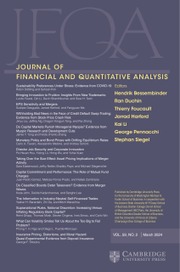No CrossRef data available.
Article contents
Tackling the Volatility Paradox: Spillover Persistence and Systemic Risk
Published online by Cambridge University Press: 08 April 2025
Abstract
Financial losses can have persistent effects on the financial system. This article proposes an empirical measure for the duration of these effects, Spillover Persistence. I document that Spillover Persistence is strongly correlated with financial conditions; during banking crises, Spillover Persistence is higher, whereas in the run-up phase of stock market bubbles, it is lower. Lower Spillover Persistence also associates with a more fragile system, for example, a higher probability of future crises, consistent with the volatility paradox. The results emphasize the dynamics of loss spillovers as an important dimension of systemic risk and financial constraints as a key determinant of persistence.
- Type
- Research Article
- Information
- Copyright
- © European Central Bank, 2025. Published by Cambridge University Press on behalf of the Michael G. Foster School of Business, University of Washington
Footnotes
This article supersedes what used to be an initial idea first formulated with Helmut Gründl in the previously circulating drafts “Systemic Risk: Time-Lags and Persistence” and “How Persistent Are Equity Shock Spillovers?” I thank Helmut for many fruitful conversations at these early stages. I am grateful to an anonymous referee, Lauren Cohen, Jean-Edouard Colliard, Hans Degryse, Johanna Eckert, Rob Engle, Thierry Foucault (the editor), Till Förstemann, Mila Getmansky Sherman, Paolo Giudici, Robin Greenwood, Tobias Herbst, Ralph Koijen, Michael Kötter, Wolfgang Kürsten, Matt Linn, Mei Li, Andrea Modena, Johanna Mühlnickel, Felix Noth, Martin Oehmke, Lasse H. Pedersen, Loriana Pelizzon, Diane Pierret, Peter Raupach, Oliver Rehbein, Simon Rother, Farzad Saidi, Christian Schlag, Isabel Schnabel, Sascha Steffen, Quentin Vandeweyer, Haoxiang Zhu, and to participants at the 2021 Eastern Finance Association meeting, 6th IWH FIN-FIRE Workshop, 7th Bonn Research Workshop in Financial Economics, 2017 AFA meeting, 2016 ICIR-SAFE Systemic Risk Workshop, 2016 DGF meeting, 2016 ARIA meeting, 2016 Huebner Doctoral Colloquium, and at seminars at Deutsche Bundesbank, UMass Amherst Isenberg School of Management, MIT Sloan, University of Guelph, University of Jena, and St. John’s University for helpful comments. I thank Markus Brunnermeier, Simon Rother, and Isabel Schnabel for sharing their data on asset price bubbles.
Funding: I gratefully acknowledge financial support from the International Center for Insurance Regulation (ICIR) at Goethe-University Frankfurt, from the research cluster ECONtribute, funded by the Deutsche Forschungsgemeinschaft (DFG, German Research Foundation) under Germany’s Excellence Strategy – EXC 2126/1 – 390838866, and from the German Insurance Science Association (DVfVW). The views expressed in this article are the author’s and do not necessarily reflect those of the European Central Bank or the Eurosystem.


